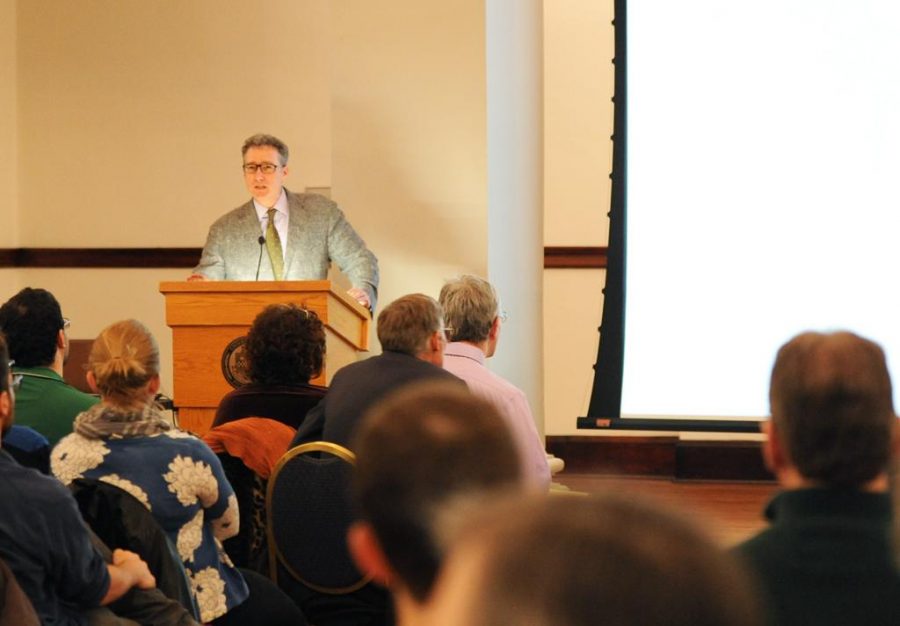Amid a citywide debate on how to safely share roadways between pedestrians, cyclists and motorists, Pittsburgh officials discussed plans to improve the city’s roadways Tuesday night in Alumni Hall.
More than 200 community members congregated from 6:30 to 8 p.m. in the Connolly Ballroom for a public meeting about the National Complete Streets Coalition. In April, Mayor Bill Peduto announced the city would join the nationwide initiative, which has used urban design to improve the safety, efficiency and beauty of city streets across the country since 2004.
The project will redesign roadways, forcing motorists to slow down while also making commuting more efficient and directing traffic to local businesses. The city has not decided which roadways to target, but according to City Planning Director Ray Gastil, Complete Streets will make the community more cohesive by improving multiple transportation networks at once.
“Through Complete Streets policies and programs, we will commit to the quality design and maintenance of rights of way and further mark Pittsburgh as a leader in 21st century planning,” Peduto said in his order.
Gastil said the city plans to finish the Complete Streets project by 2016.
The meeting comes after recent motorist crashes darkened the city — including one last month that resulted in the death of Pitt adviser Susan Hicks. In response to the tragedy, advocacy group Bike Pittsburgh collaborated with Pitt students to highlight local bike safety. Greg Dornseif, sophomore finance and marketing double major, created a petition to show community support for bikers, and graduate student Matt Bauman released data on speeding vehicles.
The coalition will meet with community stakeholders such as city staff, Port Authority, the Pennsylvania Department of Transportation and others on Wednesday to speculate goals for the program, discuss an effective plan for Pittsburgh and begin drafting policy language.
“This is a community issue,” Emiko Atherton, director of Complete Streets, said. “Our roadways are still dangerous by design.”
The project will give visitors and residents the “choice and opportunity” to travel without using cars, according to Gastil. More people commuting via bike or foot would improve foot traffic of city sidewalks and will drive economic progress, he added.
Gastil said 40 of Pittsburgh’s 1,298 miles of roadways have bike lanes, but “no one expects for there to be 1,298 miles of bike lanes.”
“People value walkable cities,” traffic engineer Jeff Riegner said. “I’ve never seen a car buy something.”
Gastil said programs like Open Streets Pittsburgh have already proved city officials are working toward engaging the community and that Complete Streets will make Pittsburgh safer.
“The foundational question for Complete Streets is how this works toward safety,” Gastil said. It will make “streets that are actually a place you want to be.”
Riegner, who also spoke at the meeting followed by a short Q&A with the audience, explained how Complete Streets will transform the city’s roadways and improve its infrastructure. He said Complete Streets can accommodate to all types of vehicles.
“Speed is the principal determiner of safety in streets,” Riegner said.
Riegner added that the project isn’t necessarily expensive, either. Cities need to repaint lanes once roadways have been repaved anyway, so they can save money by painting on Complete Streets.
Earlier this year, the Department of City Planning submitted a request to the Southwestern Pennsylvania Commission for nearly $4 million to help fund construction for a bike corridor from Downtown to Squirrel Hill on either Forbes or Fifth avenue. SPC is still reviewing the request.
Daniel Cessna, PennDOT district executive, said in October that it will be difficult to add bike lanes in Oakland because they would replace traffic lanes or parking spaces. The busy neighborhood is the third largest business district in the state.
The National Complete Streets Coalition, based in Washington, D.C., launched in 2004 and has nearly 800 policies nationwide, said Atherton. But most of these policies are in suburban settings rather than cities like Pittsburgh. The Coalition has also partnered with cities like New Orleans and Memphis, Tennessee, to bring Complete Streets to more urban sites.
Riegner accompanied his presentation with graphs and data about roads that have been successfully engineered into Complete Streets, using Pottsville, Pennsylvania, as an example.
Regardless of location or presentations, the goal of Complete Streets remains the same.
“What matters most is making sure people have safety … from here to there,” Gastil said.
Elizabeth Lepro contributed to this story.



